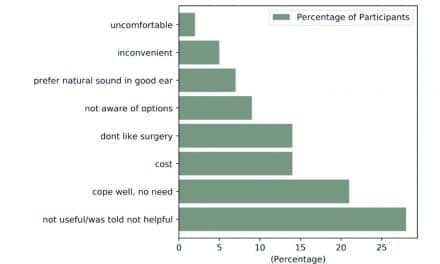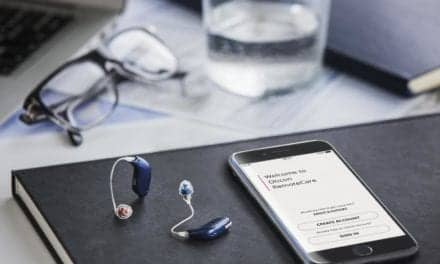Opinion | Hearing Review July 2014
How your business can thrive and win in the face of dramatic distribution changes
By Gyl A. Kasewurm, AuD
It’s an interesting and unprecedented time in hearing healthcare. For those of us who dispense hearing aids, we are facing commoditization. Hearing aids are becoming simple commodities in the eyes of consumers, and the need and value of having a professional degree with as much as 8 years of education involved is being questioned and devalued.
Consumers have a large number of options when purchasing hearing aids, and the focus from providers in Big Box megastores is shifting toward competition on price alone. Historically, it has been common practice for hearing care professionals to “bundle” into one packaged price the charge for the hearing aids and the cost of diagnostic and follow-up services. The consumer typically has had no idea how much of that price is for the device(s), and how much is the cost of the services that go into testing, fitting, programming, and adjusting and supporting those devices for a period of 5+ years after the initial purchase. In the end, all the patient sees is an invoice for thousands of dollars.
Understanding the New Dispensing Landscape
The aging of Americans and the concomitant growth in the number of potential patients with hearing loss have produced some unique providers of hearing healthcare. Costco—a Big Box retailer where consumers can buy anything from toilet paper to canned goods to underwear in bulk—has become a large provider of hearing aids, with 438 hearing aid centers as of May 2014. In the past 4 years, Costco’s hearing aid sales have experienced dramatic growth—26% in 2013, according to Richard Chavez, Costco’s senior vice president in charge of ancillary businesses.1,2
At Costco, a basic in-the-ear hearing aid can cost as little as $500, and more advanced models sell for $900-$1,500 per unit. These prices are often less than independent providers are paying for the units. Costco’s prices are less than half that of the average price of aids in the United States, despite the fact that their hearing aids are produced by the same major manufacturing companies that audiologists and hearing instrument specialists buy their units from.
Today, four of the “Big 6” hearing aid manufacturing groups (Sonova via Phonak, William Demant Holding via Bernafon, GN, and Siemens via Rexton) sell products to Costco. The opportunity in adding hearing aids to the diverse product mix at Costco became clear to Chavez as much as 10 years ago. “I remember thinking, we have a lot of traffic, and we don’t have to advertise,” Chavez commented. “It was one of those classic little business moments, where you see the opportunity right in front of you.” Chavez went on to say, “We’re now one of the largest—if not the largest—hearing aid distributor in the market, but I really don’t want anyone to know that.”1
It was a matter of Costco bringing its business practices into hearing healthcare by selling a high-tech customized product the same way it does all of the other products it sells in bulk. Costco tapped the industry’s main manufacturers to produce a line of its own private label hearing aids, such as the Kirkland brand, which is manufactured by GN. Wal-Mart and its Sam’s Club stores also sell plenty of hearing aids along with many online retailers, which have cut into the market share of audiologists and hearing aid dispensers.
This commoditization of hearing healthcare is spreading, and even insurance providers are changing the way hearing aids are dispensed. One insurer, United Healthcare, sells the devices directly to consumers through its sister company, hi HealthInnovations. Blue Cross and Blue Shield has partnered with the online provider TruHearing, where the patient purchases the aids from TruHearing and they pay an audiologist or dispenser to fit them to the patient.
How Worried Should We Be?
So, can independent practitioners compete with these changes in distribution? In an effort to investigate this issue, I took my husband, who has a bilateral moderate sensory hearing loss, to three different Big Box providers to be fit with hearing aids. We visited the hearing aid departments in two Costcos and another in a local supermarket chain (Meijer Inc) that sells the same aids as Sam’s Club (but to my knowledge has no affiliation with Sam’s Club). This proved to be a fascinating and eye-opening experience.
Costco. One of my major suppliers is also a Costco supplier, but my representative and the executives at that company had assured me that they were using a private label and that their brand name would never be seen at Costco. I found this to be untrue in both of the Costcos we visited; posters featuring their brand name were very visible in the sound booth where we sat when my husband was tested.
Additionally, the dispensers at both Costcos bragged that the aids my husband was fit with were the premium product from the manufacturer that I was using. The pair sold for $1,899.99 including a remote control and a 3-year warranty. I was shocked when I heard the Costco retail price, since that was less than I was paying for a pair of premium products from the same manufacturer.
I watched carefully while the salesperson fit my husband with the aids. It was a premium product with nine channels and the same noise reduction tools that I was using every day in my own clinic. While my representative from the manufacturer had assured me that the product that I was buying wasn’t the same as the product Costco was selling, the software certainly looked the same as the software I was using in my practice.
Meijer. The aids that my husband was fit with at the Meijer store were definitely not as sophisticated as the aids at Costco. They had audible feedback that the dispenser couldn’t seem to resolve and the sound quality was inferior to the Costco aids.
The best aids were sold to us for $3,900, but we were told that we could receive a 10% discount if we used a Meijer credit card to purchase the aids and another 10% discount if we purchased the aids on a Friday or Saturday. I commented that I thought the latter was an odd practice, but the dispenser extolled, “What difference does it make for the reason? It’s Saturday so, if you purchase today, you get the extra 10% discount!” There were no penalties for return and the aids came with a 3-year warranty that covered all repairs and adjustments.
Before these experiences, I spent some sleepless nights wondering if independents like myself could survive this commoditization of hearing healthcare. After my experience at three Big Box stores, I am more convinced than ever that independents certainly can and will survive. But it may be necessary to change some of our “typical practices.”
What do we have that these Big Box retailers don’t? What follows are some observations and suggestions on how independent practitioners can compete in these unique times.
Qualifications and Expertise
While Costco and other Big Box retailers do employ some audiologists, most are staffed by their former salespeople. Both of the dispensers at the Costco centers we visited had been hired and trained from within the Costco company and had only 6 to 9 months of experience in the hearing field. So, they literally may have been stocking shelves 6 months before. It was our experience that the person who evaluated my husband’s hearing in the hearing aid department at Meijer Inc was a licensed hearing aid specialist and had worked in another practice for several years prior to coming to Meijer.
The approach to testing and fitting was very similar in all three locations we visited. There were no explanations regarding the type and degree of hearing loss, and no choices were given when it came to hearing aids. The dispensers showed us a RIC type hearing aid and said, “This is the best aid for you.” Period. No choices and no mention of any different levels of technology. In fact, the approaches were so similar, they actually used the same wording to describe the testing process.
The testing and fitting at both of the Costco locations was conducted while my husband, the salesperson, and I sat together in a 6 x 6 sound room. This enabled me to closely observe the testing and fitting process. I asked both salespersons what I consider to be simple questions regarding the testing process that neither was able to answer. When one explained that my husband had a “profound” loss, I remarked, “That sounds like a serious problem. Should my husband be seen by a physician to see if anything can be done about the loss?” He replied, “I don’t know, I am not a doctor,” then continued with the testing.
Since I was sitting and watching during the testing, I could observe that the audiograms completed in both Costco locations were somewhat different than the one I have repeatedly obtained in my practice. While our two experiences may not represent the expertise of the average Costco dispenser, clearly the staff that we dealt with did not have the education or expertise of a Doctor of Audiology or an experienced hearing aid dispenser.
Again, it should be acknowledged that this is based on only two stores, and these were probably staff members who were relatively new to dispensing hearing aids. However, I also believe that, with the steady growth of these Big Box suppliers, hiring and training enough experienced professionals to staff their locations will continue to be a major obstacle for this market segment.
The Patient Experience
The hearing aid department at the grocery store was sandwiched between hair care products and dental supplies. The ones at Costco were housed in a single 6 x 6 foot booth in a large warehouse stocked with all kinds of other products. While this type of atmosphere may be appealing to some, the patient experience is certainly a place where independents can excel. Research has shown that patients are willing to pay more for a good experience—even in a down economy.
It is often the little details that patients will recall even more than the product they purchased or the service they received, and these details may be the reason a patient will want to do business with you again. Greeting your patient and the person who usually accompanies him or her as soon as they enter the office can be a meaningful and treasured detail that can add to the experience. People dislike having to wait an excessive amount of time for their appointment to begin, especially if they aren’t kept informed as to the reason for the wait. Long wait times show a lack of respect for a patient’s time. When running behind schedule, make sure the staff informs the patient, apologizes for the delay, and gives an estimated waiting time. It’s also a nice idea to give a patient the choice to reschedule when the wait becomes excessive.
For high levels of patient satisfaction, you need to sweat the small stuff. If your patients spend a few minutes in your practice, you have the opportunity to turn their appointment into a captivating experience. I recently organized a staff outing to a nice restaurant in which the staff were treated with “over the top” service so they could experience firsthand the type of service I want them to provide to our patients.
Most people can recall a coffee shop waitress who doesn’t ever need to be told how they like their coffee or a restaurant hostess who knows your special table. I have a shoe salesperson who calls me every time a new style of my favorite brand hits the showroom. These experiences and special touches add value, and they also can instill an enormous amount of loyalty from patients.
What do you do to show patients that you appreciate them? As I mentioned earlier, patients can literally go anywhere for hearing aids so what special touches can you provide that will guarantee patients will return to you?
Little details are so easy to overlook and so tempting to brush off as unimportant, but it’s the little details that can make all the difference. The refreshments you serve, the convenient hours you offer, sending flowers for special birthdays, or the smile on everyone’s faces can add up to a very meaningful experience. It’s those details that cause a patient to rationalize paying more because they feel they are getting more. It’s the little details that keep people talking about you and recommending their friends and relatives to you.
Anyone can do the big things right; it’s the little things that differentiate one business from another. Creating one-of-a-kind experiences every time a patient comes through your door or visits your website can be the advantage that overcomes the competition from Big Box suppliers.
Customer Service
Customer service is a strong influencer for many consumers. Everyone wants to be made to feel like a king or a queen, and especially when they pay a large sum for something. Zappos certainly caters to their customers by offering overnight service, free shipping, and no charge for returns. According to the American Express Global Customer Service Barometer, 81% of consumers indicated that they were more likely to give a company repeat business after a good service experience.
A focus on customer service includes answering the phone in a pleasant upbeat voice. Remember, it’s often not what you say but how you say it, and it’s important to take time to thoroughly answer a patient’s questions. I recommend that you make every effort not to put a patient on hold for any extended period of time. If you expect to be tied up for more than a minute, ask the patient if it’s acceptable to call them back at a designated time and then make certain you do what you said you would do.
In addition, attempt to solve a patient’s complaints quickly and completely. Asking the patient, “What would you like me to do?” can go a long way in determining exactly what will satisfy the patient. In addition, it is necessary to train employees to make decisions on their own so a complaint can be solved on the spot without having to talk to “the boss.”
My staff and I make it a policy to under-promise and over-deliver. The motto we live by is “Find a way to say Yes when everyone else says No.”
Best Practices
An investigation several years ago by many seasoned researchers indicated that as many as one third of fittings completed by audiologists and hearing instrument specialists were inappropriate and did not provide the proper gain for the patient.3-5 Perhaps this is because too many providers spend their time instructing patients how to insert the aids, sharing details about warranties and batteries, and then pressing “Best Fit” in the software and sending them on their way.
Performing detailed testing and completing outcome measurements are essential in making certain the hearing aids are performing as well as possible for the patient’s individual hearing loss.6 In addition, completing real ear measurements, aided discrimination, using recorded speech materials, and conducting speech-in-noise testing are also essential for getting the best possible results for a patient. It’s also helpful to give patients some idea of what the real world will sound like by playing audio clips of various sounds and listening environments before they leave with new hearing aids.
If we want to do a better job than Big Box retailers, then we really must do a better job and give our patients more of the tools that will help them become successful hearing aid users.
Unbundling
The conventional method of pricing in most hearing healthcare practices is in a “bundled” or “packaged” format, where fees associated with the hearing aid evaluation, selection, purchase, fitting, follow-up care, and service are billed in a single charge with the hearing devices. However, it is now becoming necessary to “unbundle” or “itemize” the costs of the devices, accessories, and services associated with hearing aid dispensing and billing for them separately as they occur.
Perhaps it is time to present patients with both options and let them decide which pricing method they prefer. It has been my experience that the money involved when unbundling is often similar to what the patient would have paid in the bundled price, but they did not pay it all up front and were able to spread the cost out over time. Creating a fee structure that separates the cost of the hearing devices from the services associated with the evaluation, fitting, orientation, delivery, counseling, and long-term care and management of the devices can provide the opportunity to highlight the importance of the professional services in the success of the hearing aid fitting.
Some patients believe that a hearing aid is basically just a microphone and amplifier. They can’t comprehend why it costs thousands of dollars. For years, our manufacturing “partners” have been assuring us that our personal brand and our expertise are what separates us from the competition and it doesn’t matter what the competition does. And yet, now these same “partners” are selling aids to our competition at prices much less than we are paying for similar products.
While we can’t compete on price alone, we certainly can provide our expertise, our education, an amazing experience, over-the-top service, and best practices that can’t be compared to low-cost Big Box providers. It also may be time for independents to take a hard look at the pricing policies of those supplying direct competitors in our markets and ask what realistic objectives are needed in order for us to compete more aggressively on price. Without question, some of these would involve sacrifices and commitments on our part, as well.
However, one thing is clear: obstacles like the growth of Big Box hearing aid suppliers can become opportunities if handled properly.
References
1. Stock K. July 13, 2013. Why CostCo rules in hearing aids and gummy bears. Bloomberg Businessweek. July 13, 2013. Available at: http://www.businessweek.com/articles/2013-07-11/why-costco-rules-in-hearing-aids-dot-as-well-as-gummie-bears
2. Strom KE. Has Costco become king of US hearing aid retailing? Hearing Review. 2013;20(10):6. Available at: https://hearingreview.com/2013/07/hr-blog-has-costco-become-king-of-us-hearing-aid-retailing-2
3. Aarts NL, Caffee CS. The accuracy and clinical usefulness of manufacturer-predicted REAR values in adult hearing aid fittings. Hearing Review. 2005;12(12):16-22. Available at: https://hearingreview.com/2005/11/the-accuracy-and-clinical-usefulness-of-manufacturer-predicted-rear-values-in-adult-hearing-aid-fittings
4. Aarts N, Cafee C. Manufacturer predicted and measured REAR values in adult hearing aid fitting: accuracy and clinical usefulness. Int J Audiol. 2005;44:293-301.
5. Aazh H, Moore BC. The value of routine real ear measurement of the gain of digital hearing aids. J Am Acad Audiol. 2007;18:653-664.
6. Kochkin S, Beck DL, Christensen LA, Compton-Conley C, Kricos PB, Fligor BJ, McSpaden JB, Mueller HG, Nilsson MJ, Northern JL, Powers TA, Sweetow RW, Taylor B, Turner RG. MarkeTrak VIII: The impact of the hearing healthcare professional on hearing aid user success. Hearing Review. 2010;17(4):12-34. Available at: https://hearingreview.com/2012/03/marketrak-viii-the-key-influencing-factors-in-hearing-aid-purchase-intent
Original citation for this article: Kasewurm G. An independent practice’s guide to battling big box retail and commoditization in hearing healthcare: How your business can thrive and win in the face of dramatic distribution changes. Hearing Review. 2014;21(7):18-21.






